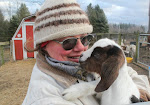 Despite offering her some grass hay, alfalfa hay and even a little sweet feed, Emma hasn't been too interested in eating since calving on Wednesday. To coax back her appetite, I decided to set her up on the freshest, choice grass and clover on the farm. That patch also happened to be our front yard.
Despite offering her some grass hay, alfalfa hay and even a little sweet feed, Emma hasn't been too interested in eating since calving on Wednesday. To coax back her appetite, I decided to set her up on the freshest, choice grass and clover on the farm. That patch also happened to be our front yard.  After spending the time to get the portable paddock all set up, Emma refused to get up. Finally, I gave her an ultimatum--either get up or lose out on fresh grass. Nothing was lost in translation and she lumbered to her feet. Once outside, her head went down and that's where it stayed for the next few hours while the calf followed her around nosing all four teats, which she is now draining, thus, alleviating my need to milk much. Thanks to all that good milk, the calf had plenty of energy to burn off running around in the grass.
After spending the time to get the portable paddock all set up, Emma refused to get up. Finally, I gave her an ultimatum--either get up or lose out on fresh grass. Nothing was lost in translation and she lumbered to her feet. Once outside, her head went down and that's where it stayed for the next few hours while the calf followed her around nosing all four teats, which she is now draining, thus, alleviating my need to milk much. Thanks to all that good milk, the calf had plenty of energy to burn off running around in the grass.When I did a 'barn check' prior to turning out all the lights for the night, there was Emma chewing her cud and her calf by her side.
 A BIG THANK YOU to everyone who has come out to support the Carlisle Central Farmers Market! Our stand continues to evolve. This week I was able to pick some red beets, tomatoes, chard and kale to take along. The hot items this week were our all-natural bratwursts, the Wallaby cheese from Keswick Creamery and the fresh pastured chickens from Otterbein Acres. Each week I have met many new people as well as learned to recognize the regulars. The market continues to grow and expand. Saturday hours have been extended an extra hour, plus there will be all sorts of special events taking place in November. On the 3rd, the Critical Mass Bike Race will end at the Farmers Market. On the 10th, there will be a Medieval Event, sponsored by the local SCA groups and on the 16th & 17th, there will be a Holiday Market in conjunction with the kickoff of Carlisle's Holiday Festivities. Hope to see you there!
A BIG THANK YOU to everyone who has come out to support the Carlisle Central Farmers Market! Our stand continues to evolve. This week I was able to pick some red beets, tomatoes, chard and kale to take along. The hot items this week were our all-natural bratwursts, the Wallaby cheese from Keswick Creamery and the fresh pastured chickens from Otterbein Acres. Each week I have met many new people as well as learned to recognize the regulars. The market continues to grow and expand. Saturday hours have been extended an extra hour, plus there will be all sorts of special events taking place in November. On the 3rd, the Critical Mass Bike Race will end at the Farmers Market. On the 10th, there will be a Medieval Event, sponsored by the local SCA groups and on the 16th & 17th, there will be a Holiday Market in conjunction with the kickoff of Carlisle's Holiday Festivities. Hope to see you there!






















